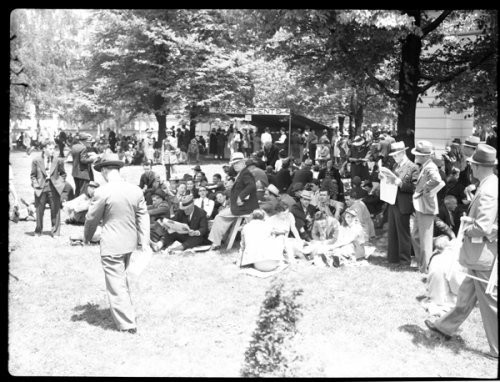What year was the Infield Tunnel built?

All photos featured in this blog post are credited to Churchill Downs Racetrack.
One of the most enjoyable parts of working with the historic photos of Churchill Downs is conducting research. It calls for finding clues in the photos, reading books, letters, consulting old racing programs, and exploring the Internet in an effort to write accurate descriptions. This is so much fun! While the photos in the collection appear to be dated correctly, a few times we’ve run across some discrepancies or thought, “Oh wait, that might not be right.”
In this case we know these photos are from 1939 but we’re a tiny bit unsure of the story they portray. Here is what we are trying to validate: was the tunnel to the infield opened in 1939?
Here is what we know:
1. The photographers, Caufield & Shook, numbered their photos sequentially. All the photos of the 1939 Kentucky Derby start with 166. Caufield & Shook took about 100 photos that year and from looking closely at a few, we are absolutely positive any photo starting with 166 is from 1939. This enlarged photo of the board shows the line-up for the 2nd race on Derby day, 1939. The photo is labeled #166091:

2. This is the first year we have any photos of the tunnel, leading us to believe Caufield & Shook were documenting the ‘grand opening’ (no pun intended) of the new access to the infield.
3. In Matt Winn’s book, Down the Stretch, he wrote: “Early in 1938, when we knew that the crowd that roams around in the grandstand area was almost causing the walls of the fences to bulge on Derby Day, we decided to lessen the pressure by building a tunnel through to the infield, and a succession of terraces in the infield to take care of the overflow.”Winn doesn’t say the construction was completed for the 1938 Derby and we were allowing for frozen ground delays and planning, so thought maybe the tunnel was scheduled to open in 1939.
4. The tunnel just looks brand-spanking new!

This all seemed pretty legitimate and we were prepared to state that 1939 was the opening of the new tunnel to the infield. But then, we found more information that gave us pause:
5. Kentuckyderby.com states this factoid: ”1938 – A tunnel is constructed under the racetrack that connects the grandstand, spectator seats to the field inside the racetrack, called the “infield”. Admission is 50 cents to enjoy the Derby from the infield. Lawrin wins the Derby and he is the first to take to a stand built in the infield for the official presentation to the Kentucky Derby winning horse.”--Lawrin won the Derby in 1938 so maybe we were wrong about the construction timeline? But this photo (from 1939) states admission to the infield is free:

Granted, perhaps admission to the track still applied and this was just to let spectators know they could enter the infield for free. Or maybe it was .50 in 1938 and then free in 1939? We may be overthinking this part of the clue.
6. Also found on Kentuckyderby.com: “Tunnels were constructed under the track in1937 to provide better patron access to the infield, which was also known as the “centerfield” in yesteryear.”
7. There is one photo floating around on the Internet showing a low aerial of the construction of the tunnel and it is dated 1937. However, this photo only appears on Pinterest so its date cannot be validated.
8. From the Louisville Times, 1937: "The immediate program as mapped out by the maestro of the greatest show in American racing, calls for a terraced infield, a tunnel under the track, a new paddock, new racing secretary's office, new cafeteria, new judges' pagoda, additional betting sheds, more terrace seats, new entrances, and additional gardens, just to mention a few of the outstanding features." Still, there is no solid mention of a finish date.
It is a little remarkable that the history of such a great institution can be a little muddy in spots (again, really, no pun intended) but we would like to have an accurate date and put to rest the little mystery of the year the tunnel opened.
Can you help?


